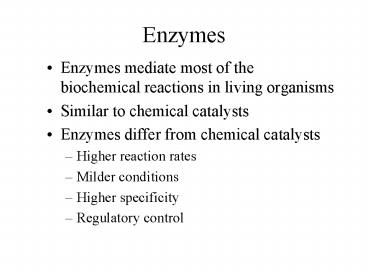Enzymes
1 / 16
Title: Enzymes
1
Enzymes
- Enzymes mediate most of the biochemical reactions
in living organisms - Similar to chemical catalysts
- Enzymes differ from chemical catalysts
- Higher reaction rates
- Milder conditions
- Higher specificity
- Regulatory control
2
Six Major Groups of Enzymes
- Oxidoreductases
- Oxidation-reduction
- Transferases
- Group transfer
- Hydrolases
- Transfer of functional groups to water
- Lyases
- Addition or removal of groups to form double
bonds - Isomerases
- Isomerization
- Ligases
- Ligation of two substrates at the expensive of ATP
3
Six Major Groups of Enzymes
- 1. Oxidoreductases
- Oxidation-Reduction Reactions, e. g.
- Lactate dehydrogenase
- Pyruvate NADH H Lactate NAD
4
Six Major Groups of Enzymes
- 2. Transferases
- Transfers of groups, e.g.
- Protein kinase
- Protein-OH ATP Protein-P ADP
5
Six Major Groups of Enzymes
- 3. Hydrolases
- Transfer of functional groups to water. e.g.
- Urease
- Urea H2O CO2 2 NH3
Protease
6
Six Major Groups of Enzymes
- 4. Lyases
- Addition or removal of groups to form double
bonds, e.g. - Aldolase
- F-1,6-bisphosphate DHAP GAP
7
Six Major Groups of Enzymes
- 5. Isomerases
- Isomerization of one molecule, e.g.
- Phosphoglucose isomerase
- Glucose-6-P Fructose-6-P
8
Six Major Groups of Enzymes
- 6. Ligases
- Ligation of two substrates at the expense of
high energy phosphate bonds, e.g. DNA ligase
9
Enzymes Do Not Change the Equilibrium Constant of
the Reaction
A B
C D
CD
Reaction quotient QP
AB
DG DG0 RT lnCD/(AB) DG0 RT ln
(Qp) R 1.987 x 10-3 kcal/mol/deg, T 298 k
(room temperature 25oC or 273.15 25 k) DGA
DGA0 RT lnA DGB DGB0 RT lnB DGC
DGC0 RT lnC DGD DGD0 RT lnD DG
DGC GD - (DGA DGB) DG0 RT lnQp
10
Enzymes Do Not Change the Equilibrium Constant of
the Reaction
DG, the free-energy difference between the
products and reactants DG0, the DG at standard
conditions (i.e. all concentrations 1M) DG0,
the DG0 at standard biological conditions (i.e.
at pH 7.0, H activity is 1, H2O is 1). DG
DG0 RT ln (Qp) When DG (not DG0) is
negative, the reaction will occur
spontaneously. When DG 0, (at equilibrium) Qp
Keq 0 DG0 RT lnKeq DG0
- RT lnKeq DG0 reflects the equilibrium
constant of the reaction
11
Reaction Equilibrium
Keq 5
A
B
At time 0
0 M
2 M
At equilibrium
? x
? 2-x
Keq B/A x/(2-x) 5 X 10 5x 6
x 10 x 1.67 M A 2-1.67 0.33 M B
1.67 M
12
Reaction Equilibrium
Keq 5 M-1
A B
C
At time 0
0 M
2 M
1 M
At equilibrium
? x
? 2-x
? 1-x
Keq C/(AB x/((2-x)(1-x)) 5 X
5(2-x)(1-x) 5x2 - 15x 10 5x2 - 15x 10 x
0 5x2 - 16x 10 0 x1 0.852 x2
2.348 A 1.148 M B 0.148 M C
0.852 M
13
Enzymes Accelerate the Process to Reach the
Reaction Equilibrium
The reaction rate is determined By free energy
of activation DG.
14
Formation of Enzyme-Substrate Complex (ES)
Decrease Free Energy of Activation
- Active site is a 3D structure
- Substrates bind to active site by multiple
non-covalent interactions - Active site defines specificity of its
- substrates. (Lock and Key model)
- Emil Fischer in 1890
15
Formation of Enzyme-Substrate Complex (ES)
Decrease Free Energy of Activation
- Active site may assume a new
- conformation after substrate binds.
- (Induced-Fit model)
- Daniel Koshland 1958.
- Dr. Koshland died in July 23, 2007.
16
Reaction Rate and Rate Constant
A
P
Rate V -?A/?T ?P/ ?T V k A (first
order reactions) A B
P
V k AB (second order reactions)
(pseudo-first-order reactions)































